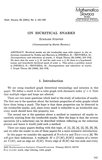Article
Full entry |
 PDF
(0.6 MB)
Feedback
PDF
(0.6 MB)
Feedback
 PDF
(0.6 MB)
Feedback
PDF
(0.6 MB)
Feedback
References:
[1] BRINKMANN G.-STEFFEN E.: Snarks and reducibility. Ars Combin. 50 (1998), 292-296. MR 1670597 | Zbl 0963.05050
[2] CAMERON P. J.-CHETWYND A. G.-WATKINS J. J.: Decomposition of snarks. J. Graph Theory 11 (1987), 13-19. MR 0876199 | Zbl 0612.05030
[3] FIORINI S.: Hypohamiltonian snarks. In: Graphs and Other Combinatorial Topics (M. Fiedler, ed.), Teubner-Texte Math. 59, Teubner, Leipzig, 1983, pp. 70-75. MR 0737016 | Zbl 0535.05045
[4] GOLDBERG M. K.: Construction of class 2 graphs with maximum vertex degree 3. J. Combin. Theory Ser. B 31 (1981), 282-291. MR 0638284
[5] ISAACS R.: Infinite families of non-trivial trivalent graphs which are not Tait colorable. Amer. Math. Monthly 82 (1975), 221-239. MR 0382052
[6] NEDELA R.-ŠKOVIERA M.: Decompositions and reductions of snarks. J. Graph Theory 22 (1996), 253-279. MR 1394327 | Zbl 0856.05082
[7] ŠKOVIERA M.: Dipoles and the existence of irreduciЫe snarks. (In preparation).
[8] STEFFEN E.: Classifications and characterizations of snarks. Discrete Math. 188 (1998), 183-203. MR 1630478
[9] WATKINS J. J.-WILSON R. J.: A Survey of snarks. In: Graph Theory, Combinatorics and Applications (Y. Alavi et al., eds.), Wiley, New York, 1991, pp. 1129-1144. MR 1170851 | Zbl 0841.05035

